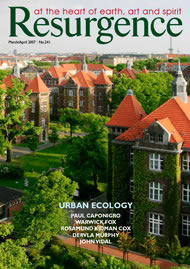BREAST CANCER CASES have hit a new record and the increase shows no sign of slowing. The latest UK government statistics, published in September 2006, confirm that incidence has risen 80% in three decades and continues on an upward trend. Breast cancer is now the commonest form of cancer in the UK, and by far the most common cancer in women: around 42,000 women are diagnosed each year. The hidden trauma of breast cancer, both for survivors and victims, causes immense private suffering.
An increasing body of scientific evidence indicates that a multitude of synthetic (human-made) chemicals which mimic female sex hormones are present in our environment. Since both onset and progression of breast cancer is known to be influenced by hormones, the overloading of a woman’s hormonal system as a result of her life-long exposure to low levels of these chemicals may increase her risk of breast cancer. Susceptibility to such risk-laden exposures is particularly heightened during vulnerable life-stages such as foetal development, puberty, pre-menopause and older age.
Despite this common knowledge, the issue of the toxicity of synthetic chemicals and their link to cancer has, until now, been steadily refuted by government, industry and mainstream cancer organisations. Strategic expert advice to government is that breast cancer is exclusively a disease of ageing and ‘lifestyle’ factors, and that provision should be made for a greatly increased disease burden in future decades. As a result, breast cancer is envisaged to become an almost ubiquitous, fatal disease, to be controlled by pharmaceutical drugs.
The increase in breast cancer incidence, however, can only be partially explained by life choices and changes in lifestyle. In fact research has shown that less than 50% of breast cancer cases can be attributed to acknowledged risk factors (such as having a first baby late in life, not having children, poor diet, obesity and alcohol). Around one in twenty breast cancer cases is believed to be inherited, but for the overwhelming majority of women the disease is not passed on through genes, but acquired during their lifetime.
Unpublished government data indicates that mastectomy rates have jumped 44% in fifteen years, across all age groups. Most disturbingly, the upward trend is just as drastic (41%) in women aged 15–44 years old – evidence that breast cancer incidence is rising in all age groups, and is not just a disease of ageing.
THERE ARE ABOUT 100,000 synthetic chemicals on sale in Europe. Their production has increased enormously since the Second World War, and their residues have now spread widely into air, soil, water, sediments, wildlife and its habitats, and human tissues. We are exposed every day to pesticide residues in food and to synthetic chemicals in consumer products. For the vast majority of these substances, no adequate toxicity data has been collected. By 1985 it could be stated: “Of the 45,000 toxic chemicals listed by the US National Institute of Safety and Health in 1980, 2,500 were identified as carcinogens, 2,700 as mutagens [causing genetic change] and 300 as teratogens [causing malformation of an embryo]. Less than 7,000 had been adequately tested.”
Today, over 400 chemicals are currently thought by European regulatory authorities to disrupt the hormone system and are suspected to be linked to hormonally dependent cancers. Hundreds of independent scientists have signed the international Prague Declaration expressing concern about endocrine-disrupting chemicals. However, regulatory science lags behind and precautionary action is not yet being taken.
The No More Breast Cancer Campaign is urging the government to acknowledge that lifestyle factors alone cannot fully account for the inexorable rise in breast cancer. It is hoping that the government will introduce a strategic and integrated cross-government plan to reduce people’s exposure to potentially harmful substances in the environment as a precautionary measure. In practice this would mean, for example, new limits to exposure in food to pesticide residues, which currently contaminate over a third of the fresh produce we buy. The use of harmful industrial chemicals – for example, bisphenol-A in tin-can linings – would be curbed. Air pollutants would also be included, and efforts to reduce harmful emissions integrated across government. An effective monitoring system, involving tests for chemicals in volunteers’ blood and body fat, would, for the first time, provide a clear picture of the extent of our own pollution.
All these strategic measures are beyond the control of individual women and can only be taken by government. However, there are certain precautions we all have the power to take now: for example, choosing to buy organically produced food. This is beneficial because it both helps to minimise routine chemical exposure and reduces the toxic load on the environment, with the air and water pollution entailed. As consumers we can also seek out eco-friendly cosmetics, and household cleaning products that do not contain harmful chemicals.
The rising incidence in breast cancer is often obscured by government and mainstream cancer charities behind messages about funding, treatment and reductions in actual death rates. Women are becoming increasingly aware of the rising threat from breast cancer to the health of not just themselves but their daughters and granddaughters. Currently there is simply no proper redress for women whose breast cancer may have been caused by environmental pollutants. The No More Breast Cancer campaign is providing a new focus for action and debate.
For more information please phone +44 (0)845 6801322, or visit www.nomorebreastcancer.org.uk.
The No More Breast Cancer Campaign has been set up by a group of women, including the authors of this article, who have been working for years on the primary prevention of breast cancer.
Thirteen common carcinogens and endocrine disruptors – still in use
Atrazine: a pesticide approved for use in the UK where it is used extensively on food crops. It is one of twenty pesticides commonly found in drinking water, and residues have been found on radishes and carrots.
Benzene: an ingredient in waxes, resins, oils and paints.
Alkylphenol ethoxylates: Found in paints, pesticides, herbicides, plastics, cosmetics, nappies and sanitary towels, shampoos, hair-colour products, shaving gels and spermicides.
Bisphenol-A: used in dental fillings, nailpolish, food packaging and food-can lining.
Chloroform: an ingredient in medicinal products such as cough syrups, mouthwashes and toothpastes and also domestic cleaning products containing bleach. Exposure also through water sources such as tap water and swimming pools.
Ethylene oxide: found in pest-control products,
cosmetics and food packaging.
Formaldehyde: found in household cleaners, nail varnish, soaps and deodorants; also in plastic foams (cushion fillings, insulation), fabrics (leather, furnishings, clothing, tea bags), building products (plywood, particle board, flooring), decorating products (paints, sealants, pigments) and furniture.
Polycyclic musk compounds : (synthetic musks): used as fragrances to substitute natural musk in cosmetics, personal care products and detergents.
Styrene: used in adhesives, inks, cooking utensils, floor waxes and polishes, copier paper and toner, decorating materials (varnishes, putty, paints), metal-cleaners and carpet backing.
Parabens: used in most cosmetics, deodorants, shampoos, toothpastes and moisturisers and some foods and drinks (pie fillings, beers, jams and pickles).
Phthalates: used as an ingredient of inks, paints, adhesives, cosmetics, skin moisturisers and packaging materials (paper, board, cellophane).
Organochlorines: used in a vast range of everyday products from pesticides to plastics, detergents, cosmetics, bleaches and shampoos.
Pesticides: one of the largest groups of toxic, human-made chemicals to which we are routinely exposed. Most are fat-soluble, and many have been shown to be carcinogenic and hormonally active.








